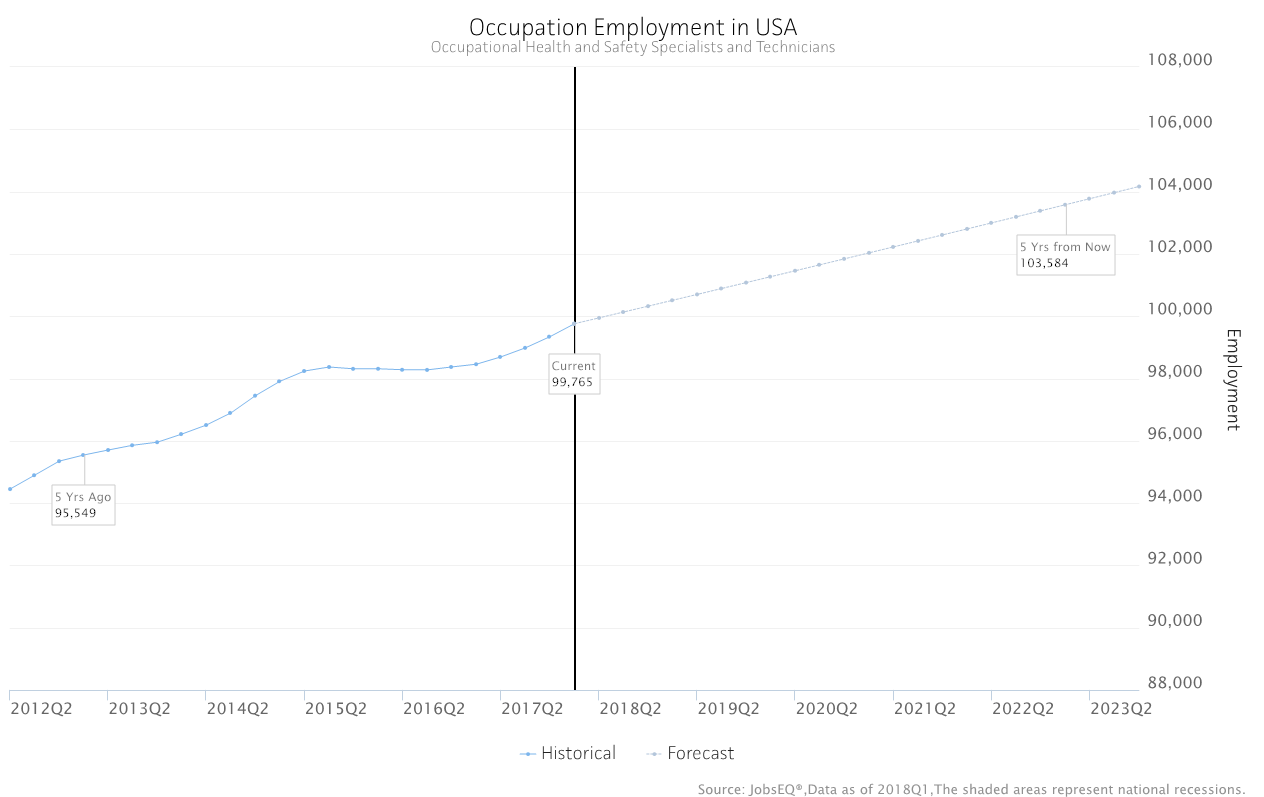Where Are Occupational Health and Safety Professionals Needed Most?

By Former Chmura Staff |
Since June is celebrated as National Safety Month, we thought it would be interesting to consider safety in the context of the workforce. When we first think of occupations related to safety, we may consider workers such as law enforcement professionals, fire fighters, and EMTs—people whose job it is to respond to a specific and often anticipated threat.
However, in addition to fields that concentrate on responding to narrowly-defined emergency situations, there are also fields that focus on prevention of a broad array of emergency situations. Namely, occupational health and safety specialists and technicians[1] evaluate the environment in a variety of workplaces in order to design and implement policies to improve safety on the job.
Currently, there are roughly 100,000 employees working as occupational health and safety specialists and technicians, and that number is projected to grow at an average annual rate of 0.8% over the next five years.
For workers who have an inclination toward safety and possess strong organizational and communication skills, this career might be a good fit. Using our JobsEQ Real-Time Intelligence[2] platform, we found that, within the last 180 days ending June 26, 2018, the skills most requested by employers include expertise in Microsoft Office, presentation, teaching/training, and language.
That being said, the availability of such work depends somewhat on where you live. Opportunities to work in occupational health and safety are concentrated more heavily in some areas than others.
Looking at the top MSAs for occupational health and safety workers by location quotient,[3] we can see that the geographic distribution of employees in this field is relatively wide—stretching from New Jersey to South Carolina to Alaska. Nevertheless, the strongest concentrations tend to fall within Texas and—to a lesser extent—Louisiana.
Why does one region employ more occupational health and safety workers than another? Well, there are likely many reasons, but one important factor to account for is the assortment of industries that are prevalent within those areas. Some industries will naturally need more guidance on matters of workplace safety than others.
When we consider the number of occupational health and safety workers employed in each industry as a percentage of all employees,[4] we gain some insight as to why some regions may be more reliant on occupational safety professionals.
While the number of occupational health and safety workers across all industries[5] averages out to about one in every 1,500 employees, the top ten industries range from one per 250 to one per 75 employees. Four industries in particular employ at least one occupational health and safety professional per 100 employees: water treatment and disposal, other heavy and civil engineering construction, support activities for mining, and petroleum and coal products manufacturing.
In looking at the location quotients by MSA for each industry, we found that half of the top 20 MSAs for occupational health and safety workers listed above fall within the top ten MSAs of one of these four industries.
The industry with the highest concentration of occupational health and safety workers is waste treatment and disposal. The MSA with the 3rd highest concentration of workers in this industry is Kennewick-Richland, WA—the region that also contains the 2nd highest concentration of occupational health and safety workers. Considering that this region is the home of the most contaminated nuclear site in the US, it’s no surprise that it has become an ongoing cleanup and remediation project.
The number one MSA for occupational health and safety professionals, Midland, TX, is also the number one MSA in support activities for mining. And, finally, the Lake Charles, LA MSA, ranked 7th in terms of occupational health and safety employment concentration, is also the number one region in the other heavy and civil engineering construction industry and number two in the petroleum and coal products manufacturing industry.
While generalized knowledge in workplace standards and procedures is helpful, workers interested in pursuing a career in occupational health and safety will also benefit from gaining subject matter expertise in the industries most reliant on the field. At the same time, workforce developers in regions driven by these industries will also benefit from investing in training and development for occupational health and safety professionals needed to keep their workers safe and healthy enough for their local economies to flourish.
[1] Occupational health and safety specialists and technicians is an occupation measured at the five-digit SOC level (29-9010) and includes both occupational health and safety specialists (29-9011) and occupational health and safety technicians (29-9012).
[2] Real-Time Intelligence extracts online job postings on a daily basis, categorizing them by criteria such as occupation, location, employer, title, and required skills, to identify real-time job demand.
[3] Derived from the BLS, the location quotient (LQ) is the ratio of the regional employment for a given occupation or industry to the national average for that occupation or industry. For example, an LQ of 2 means that the regional employment is twice the national average, an LQ of 0.5 means that it’s half the national average, and an LQ of 1 means that it’s equal to the national average.
[4] Derived using staffing patterns in conjunction with occupational and industry data provided by the BLS.
[5] Industries include all four-digit NAICS codes in which there are at least 100,000 employees.
Subscribe to the Weekly Economic Update
Subscribe to the Weekly Economic Update and get news delivered straight to your inbox.
